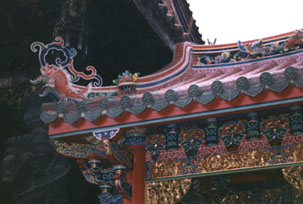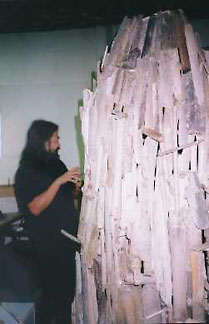A Survey
of the Art Scene
in Taiwan
(Republic of China)
by Roger McClanahan

Lungshan Temple
A Surveyof the Art Scenein Taiwan(Republic of China) by Roger McClanahan |
 Lungshan Temple |
|
I recently spent two weeks in Taiwan visiting a variety of museums, galleries, artist's studios, and alternative spaces. My trip was made on the cusp of a very crucial election, which will result in major changes in the political and cultural landscape and in some ways my visit reflects this energy, or one could call it anxiety. I would compare Taiwan to Berlin before the wall came down. Since the country has very limited official diplomatic recognition, they sponsor two cultural centers, one in New York and the other in Paris. There has also been a long-term understanding that the intellectual health of their country is closely related to the cultural freedom which they promote. As a result installation art, politically influenced conceptual work and high technology oriented work predominates in this environment. |
TaipeiWhen I arrived my first stop was the Taipei Historical Museum. The building is an old Japanese municipal building constructed at the turn-of-the-century. What was remarkable about the museum was an exhibit on Chinese technology, which originated in Mainland China. Over and over I discovered examples of cultural collaboration between Taiwan and Mainland China. More than that there is a constant communication of ideas and while direct flights have not been established between "the two Chinas," Internet communication, trips to visit relatives, and business investments are rapidly breaking down the seemingly implacable borders. |
 Lungshen Temple |
That same afternoon I visited Lungshan Temple. This remarkable place is dedicated to the deities Matsu, God of the Sea, and Kuan Yin, Goddess of Mercy. It dates from 1740 but has been rebuilt many times. It throbs with worshipers who come seeking the luck of the gods specifically to bring them children. The place is full of incense as well as high energy! I made a wish and threw two crescent shaped wooden objects. I got my wish by the way! That evening I made the first of many visits to Taipei's famous night markets. The most famous is called "Snake Alley" where snake soup is consumed to promote viagra-like effects. There are hundreds of street sellers and cheap restaurants. All these night markets are frantic and are open until two or three in the morning. |
| Of course the most famous museum in Taiwan is the world-famous National Palace Museum. The first day I was there it was spring break and "children's day" and it felt like a cross between the floor of the New York Stock Exchange and the King Tut exhibit at the Met! They have a website, which can be accessed by just using "Taiwan" and following into the cultural museum listings. It is an astonishing place and the story of how the collection was preserved is as interesting as the works are extraordinary. The National Palace Museum is currently featuring an exhibit on the Sung dynasty, which is roughly equivalent to our Renaissance. The bronzes, porcelain and paintings are sublime. Many works from the Palace Museum are not allowed to travel because of their age, rarity and value. It is a treat to see them in a museum especially created for their display. To give you some idea how important the National Palace Museum is, the director is a full member of the government's cabinet. |
| That afternoon I visited Dimension Endowment of Art in the Center of Taipei. This is a very modern gallery space, which operates a little like the DIA Foundation in New York. They sponsor artists collaborations, have an extensive library of catalogues, help arrange for curators to work with some of the major museums. They have close ties to the government's Ministry of Cultural Affairs as well as other nonprofits, alternative spaces, and museums. The day I was there they had an exhibit by Wu Cheng-hsing called "Dermatology". I visited this place with two curators from the Queens Museum who spent a great deal of time pouring over catalogues and talking with their staff. This is an important place to visit for anyone with an interest in the contemporary art scene in Taiwan. |  Body |
| Besides "night markets" the art world offers a number of diversions in Taipei. The principal point of contact for artists is "I.T.Park" an alternative space which contains a small gallery and a café with a pleasant balcony looking out on the street. The day that I visited the downstairs gallery featured a conceptual work by Lin Hung Cheng, which involved the artist's invented persona as a Russian artist living in the 20's. He created a timeline for the supposed life/career of this artist and coordinated it with events in Chinese cultural life. This is one of the best hangouts in Taipei along with the Milk Café where you can go and watch the latest in video art and meet a younger more networked group of artists and intellectuals. |
|
|
Among the more conventional galleries in Taipei are Hanart Gallery and its other site Hanart TZ Gallery. The show that was on during my visit was a massive installation piece by Yan chung Hsien who is an architect as well as an artist. His piece was a beautiful, exotic work created from bamboo sort of creating a temple with a muslin altar in the center. |
| Another gallery worth visiting is Lin and Kang, a very beautiful space that was showing an artist who reminded me of Mark Toby. In a conversation with the owner it turns out this artist was a good friend of Mark Toby leading to endless speculation about who influenced whom. |
| The central institution for contemporary art in Taipei is the Taipei Fine Arts Museum. This is a place with room for the most enormous installations and contemporary art on the most gigantic scale. There is also an art school and a program to exhibit the work of emerging artists. When I visited this space, there were six emerging artists showing their work. The curator of many of these projects is Yulin Lee who was also kind enough to show me around one of the night markets in the City. Shortly this museum which has been open since the early 80's will close for renovations, a leaking roof etc. But certainly when it reopens it will one again be the major focus of contemporary art in the City. Before the reader gets blurry-eyed at this endless list of institutions, I must mention the National Museum of History. While this sounds like it might not be that interesting, it has a superb collection of ancient Chinese art as well as major collection of costumes, scholar's artifacts, and other important collections of decorative arts. The museum is under the directorship of Kuang-nan Huang, one of the liveliest, gung-ho museum directors on the Island. There was considerable speculation that he would be made the new Minister of Cultural Affairs when the government changed hands on May 20th. In fact this did not happen. Yu-hsiu Chen who is a music professor from the Normal Taiwan University, got the position instead. Don't dismiss Mr. Huang from playing a major role in the cultural world in Taiwan in any case. |
KaohsiungThe Republic of China has not put all of its eggs in one basket for sure. One must travel out of Taipei to experience the full range of the cultural infrastructure in this country. I flew to Kaohsiung which is the major port of the country and the second largest city located about 250 miles to the south of Taipei. There one finds the enormous Kaoshiung Museum of Fine Arts which was featuring an exhibit of art from the Louvre's Orangerie Museum. The place was packed. There is also a very extensive historically organized exhibition of Taiwan's contemporary art. The main atrium is a little reminiscent of the new wing of the National Gallery. The windows look out over twenty acres of landscaped parkland not yet finished. It is a very popular place for locals to look out at their city's skyline. This is a city using cultural institutions to flex its muscle. They are saying we are a city on the move. I kept being reminded of a tropical Chicago, a second city who was trying harder and proving itself. |
| The other institution in Kaohsiung , which cannot be missed, is the National Science and Technology Museum. In a country with 98% literacy and an enormous concentration on science and technology where seemingly every person has a laptop and a cellphone and is investing in start up dot.coms, it is no surprise that the government made a decision to build an enormous museum celebrating science and technology. This may be one of the largest interactive-oriented, education-based science museum in the world. It certainly is larger than any in the Northern Hemisphere with the possible exception of the Science Museum in Toronto. Since there was not enough time to do much more than watch an orientation video, look at some of the exhibits it is hard to assess the museum other than to note the sheer scale of the place.I did ask to have a tour of the exhibit devoted to earthquakes since this was so unfortunately a timely topic in this part of Taiwan. This was a magic exhibit explaining the geology involved but also simulating an earthquake. This museum seemed to have freed itself of the endless computer screens, which can be dreary in some science centers. Because of the huge spaces involved, there was a feeling of freedom to roam around physically and even mentally. It is a place one shouldn't miss since in a way contemporary art is deeply rooted in the Taiwanese technological revolution which this museum manifests. One should say a little bit about this city. It is one of the largest container shipping centers in Asia. It has warm, tropical muggy weather, which combined with the aluminum smelters nearby produce record pollution. This city has not invested in mass transit so automobile pollution adds to the air pollution. There is also a very tropical feel to this city with palm trees everywhere and lots of lagoons and canals. One of the artists I met in this area has seized on anomie and pollution as the theme of his work. One can certainly understand his inspiration. |
 Wood |
I returned to Taipei by van up the coast stopping at artists studios and alternative spaces along the way. North of Kaohsiung we visited the studio of Lin Honh-wen who has two studios- one a former Christian church, the other a high-rise apartment building. He creates amazing ship like constructions using small chips of wood and lit from inside with mysterious glows.Often there is the sound of the sea emanating from the piece as well. He has shown widely in Taiwan and has an international outlook. He lived in New York for a while as well. continued in Part II |
| |
Art Review -NYAW.com
Click on ORDER FORM for Inquiries - PAYMENT OPTIONS for Art Purchase.
All artwork is copyright of the respective owner or artist. All other material © 2015 New York Art World ®. All Rights Reserved.